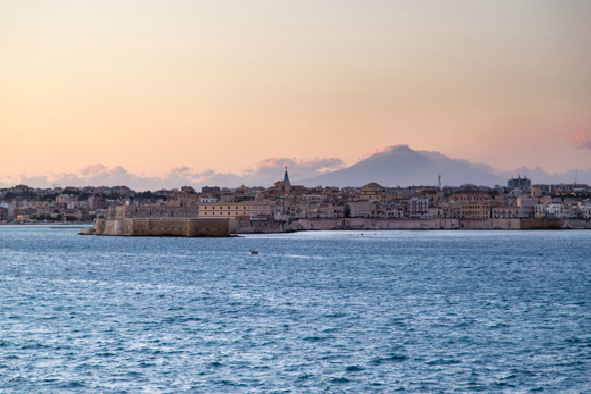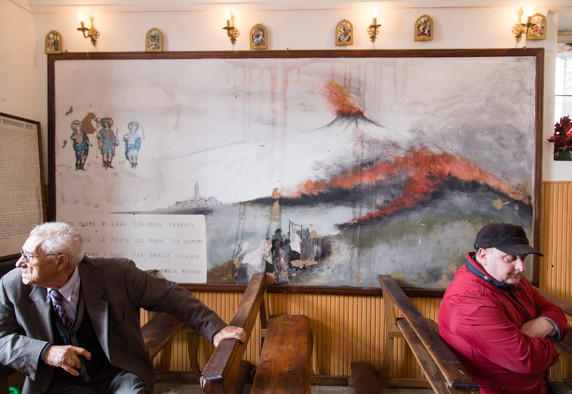Known to Sicilians as ‘the Mountain’, Mount Etna broods over the skyline and everyday affairs of this idiosyncratic Mediterranean island. Despite Etna being very much an active volcano (even erupting this week), the Sicilians take it in their stride, with the mountain a popular spot to spend public holidays and go for hikes through the volcanic landscape.

Mount Etna rising up behind Syracuse (Photo: Chris Allsop)
“Salvatore means saviour, but hopefully that be necessary,” jokes our Sicilian guide, Maria. Our beefy Italian-speaking driver Salvatore just smiles and accelerates up the autostrada. Visiting Sicily for a few days, I’ve joined Etna Excursions for a half-day foray up the volcano that’s been holding my attention even before my budget airline touched down.
From my aisle seat, I had craned to see the volcano – its peak concealed beneath a beret of lenticular cloud – as we came in to land at Catania, the island’s second city. Catania is known as the ‘black town’ – the roads and pavements paved with the volcano’s basalt rock, black as Sicilian Maria’s hair. The mountain giveth and it taketh away: Catania has suffered from severe lava and earthquake damage throughout its history, with one catastrophe in 1693 killing off half of the city’s populace.
The presence of ‘the Mountain’, as the locals refer to Etna, is pervasive: Etna pizza, Etna ice cream, Etna Spritz. I’m told that the best pistachios, the ones with the best flavour and most vivid colouring (and highest price) – are referred to as ‘l’oro’ (the gold). They too, come from the mountain. Wine, as well, with an Etna DOC label that indicates grapes grown from out of the fertile volcanic soil.
As I had travelled along Sicily’s east coast, the view of Etna – Europe’s highest volcano at 3,330 m (11,000 ft) – had shifted. At the resort-town of Taormina, it’d appeared close-up and lush, almost tropical, with sunlight breaking over its epic flanks. Behind the south-eastern city of Syracuse, it was a composed Japanese line drawing. Part of my fascination stems from hailing from a country (England) that isn’t really known for its volcanoes (let alone its mountains). But here you have three active volcanoes in a relatively small area: besides Etna there’s nearby Stromboli, as well as its sister Aeolian Island, Vulcano, sending up fireworks in the Tyrrhenian Sea.

Lava blocks a road on Etna with the active south-eastern crater smoking in the distance (Photo: Chris Allsop)
As our jeep gains altitude, Maria gives us a potted history of the island, popular for its strategic position in the Mediterranean. “In 735 BC came the Greeks, then the Romans, then the Byzantines who were followed by the Normans. After that the Spanish Bourbons for about 400 years, then came Garibaldi and the reunification.” And through all of it Etna stood indifferent. “Oh, and Coldplay filmed a music video on the mountain in 2008.” Especially indifferent in 2008.
The roads narrow, hemmed in by rough dry wall comprising basalt blocks. We enter the town of Mascoli. There are 60 towns arranged on the base of Etna’s 140 km circumference (the overall size of the volcano-mountain is roughly 1,400 square kilometres). A grey scar across the dry yet verdant landscape is pointed out as a lava flow that destroyed the original town of Mascoli in 1928. You can find black and white videos online of the town being slowly erased, with Italian workmen unscrewing the rail line while a mountain of lava rolls relentlessly towards them. In the new town, rebuilt in the 30s, there’s a handsome sculpture of Etna, like an offering to an angry god.
“There was just the one eruption last year,” Maria says. It’s been estimated that Etna has erupted some 135,000 times over 30,000 years. “The lava was like a river of gold through the snow,” she continues, clearly enraptured by the memory. Sicilians like to ski on Etna, when the lava isn’t melting the ski-lifts as it did in October, 2002. Apparently that eruption was so violent that the tourists and locals in Taormina, about an hour’s drive away, had to use their umbrellas for a few days, as black pebbles rained down on the terracotta-tile rooftops and hotel terraces.
“’Explosivo’ is Italian for explosion, ‘effusivo’ for flow,” Maria says. We continue in the jeeps, learning as we go. Besides the dry walls, the basalt is used for tiles, tables at cafes, roads. As we bounce through another pothole, I think: it’s time for another eruption. Salvatore has diverted off of the autostrada and onto an unmetalled road lined with poppies and yellow ginestra thriving in the ash grey ground. We pass solitary rustic homes surrounded by smallholdings of olive trees and grape vines before arriving at a basalt quarry. Salvatore breaks open the rocks to expose the glittering magnesium within. A fine dust turns my trainers mauve, and coats the muscular basalt walls like a silk sheet.

The volcano versus the three martyrs (Photo: Chris Allsop)
After the quarry, we stop at a local church for a more prosaic visit – a bathroom break. However, there’s an unexpected hubbub. “This is the first time Salvatore has seen the church open,” Maria translates. “You’re very lucky.” Outside of the church, the congregation smokes cigarettes and talks, waiting for the ceremony to begin. Nobody seems in any hurry. In the church’s cool, shady interior, there’s a huge painting of Etna erupting on one wall. The church was built in homage to three martyred saints – St. Filadelfo, St. Alfio, and St. Cirino – who saved the nearby town from the volcano. The statues of the saints, taken from the church and placed in the lava’s path, diverted the flow. A miracle. Out front, a bespectacled priest lowers a silver cross from a makeshift altar for a worshipper to kiss.
As we drive onwards and upwards, we pass families, together on a public holiday, barbecuing among the oak, beech, and birch woodland covering this part of Etna. Finally, we arrive. Apparently we’re only about half way up the mountain, but Etna’s south-eastern crater – the active one – is very visible, smoking at the peak. Black ash lines the road. We start our hike out to the Sartorius Mounts – extinct craters that erupted in 1865 (guided tours of the summit craters are available).

Hiking near the Sartorius Mounts (Photo: Chris Allsop)
The ground is covered with ash and basalt – it crunches with each footfall, like you’re walking on Rice Krispies. A proliferation of silver birch completes the monochrome environment. We walk up to a ridge, a crisp wind whipping over us, and peer down at a great hemisphere of solidified lava ringed by woodland; it looks like immense moles have been active beneath the broken, blackened earth. The landscape is both alien and a place of great natural beauty. And stunning views. Maria points out Taormina, a tiny cruise ship anchored in the Bay of Naxos. I think of black rocks raining down on the distant resort-town, of the immense force roiling beneath my feet. Maria says that there are regular tremors at high elevation. Fortunately, there are none today.
FURTHER INFORMATION
Book Etna Excursions’s private jeep tour of Mt. Etna (inc. a wine tasting at the Gambino winery) for £100 pp through Cassata Travel, Taormina, +39 0942 321102